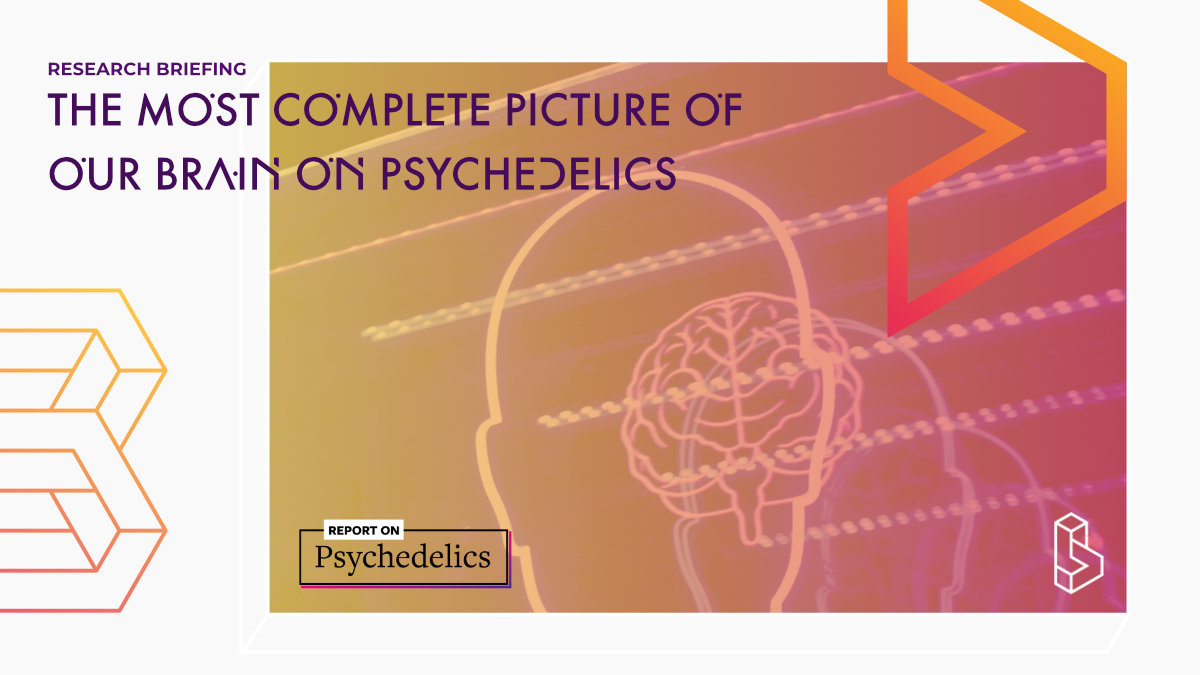This research briefing is co-published with the excellent Report on Psychedelics.
May 19, 2021
In The Research Briefing:
- The most complete picture we have of our brains on LSD
- Psychedelics may help us explore consciousness, we should also be aware of what we can’t explain
LSD
Validating the REBUS model by showing the flattened hierarchy of the brain under psychedelics
There are many different ways of peering inside our brains. We can do this with (repeated) fMRI studies that can take multiple snapshots of a brain. Another technique is called PET which can show changes in a system over time. Combining these techniques, and a few others, a pre-print paper provides more evidence for the leading theory of our brain on psychedelics.
This paper builds on earlier work that argues psychedelics relax our prior beliefs (REBUS). This framework argues that old beliefs are let go more easily and be replaced by new ideas, connections, or observations. This can explain how psychedelics allow a person to process emotions. Or how creative ideas are given space to flourish.
What makes this paper so special?
- It calculated the influence of the serotonin 2a receptor and found it to be very well positioned to the flattening of the hierarchy
- The paper combined fMRI, dMRI, PET, and NCT to show the flattening of the hierarchy from multiple angles
- The easier information flow (in a flatter hierarchy) can both explain the synaesthesia experiences as well as the letting go of old beliefs. In other words, it has great explanatory power
Our brains not only become ‘flatter’, but also show a higher level of disorder (entropy). One way to interpret this is to say that there are more options available whilst under the influence of psychedelics.
Although the paper is quite technical, the graphs do help make sense of this exciting new research. The next steps could include the same analyses with different psychedelics, at different dosages (now 75μg LSD), and to find a relationship with the subjective experience (now no significant relationship was found).
CONSCIOUSNESS
Psychedelics help us understand the contents of consciousness
Is your perception of the color red the same as mine? And how does our perception change under the influence of psychedelics? The study of/with psychedelics has given us some preliminary answers as to the content of consciousness. Under ‘altered states of consciousness’ we may experience a red rose with increased intensity, link different concepts and even link multiple senses (synaesthesia).
What psychedelics don’t (yet) tell us much about is the so-called hard problem of consciousness. Although we can measure the level of changes (as we see in the paper above), we haven’t gained answers as to why we experience anything in the first place.
This paper, by top researchers including David Yaden, Matthew Johnson, and Roland Griffiths, argues that we should be clear and humble when discussing consciousness and psychedelics.
Enlightening quotes from this paper
- “At present, there is little reason to think that psychedelics will bring us any closer to closing the explanatory gap [between subjective experiences of being and objectively observable phenomena such as brain activity].”
- “Materialist theories, favored by many scientists, regard phenomenal consciousness as identical to brain states, [but] need to explain how physical processes (e.g., the brain) give rise to qualia,” the “what it feels like” quality of being conscious.”
- “It is possible that psychedelics will allow altered states of consciousness to follow a similar path of scientific inquiry as emotions by providing a reliable means to induce and influence them in controlled settings.”
The authors argue that psychedelics can play an important role in better understanding the ‘easy problem’ of consciousness. They can be incredibly helpful when investigating brain mechanisms, creativity, and mental health disorders. At the same time, they argue that psychedelics currently have not helped elucidate the ‘hard problem’ and don’t see how they could at this time.
Research Report Readout
The anterior cingulate cortex is possibly the key locus of ketamine’s antidepressant action. The subgenual and dorsal zones of the AAC are identified as most important in the ability to feel pleasure again.
Visual disturbances (visual snow) weren’t accompanied with migraines for those with Hallucinogen Persisting Perception Disorder (HPPD), versus those without prior use of drugs who did experience headaches.
Ketamine holds potential for alcohol use disorder (AUD). This is partly motivated by the concurrent depression and PTSD that those with AUD suffer from, for which more evidence of ketamine’s effectiveness is known.
An online survey study investigated how psychedelic-induced mystical experiences improve depression, anxiety, and stress. It found that these effects are partially mediated through decreased self-rumination and increased self-compassion.
An animal study investigated the pharmacology and behavioral effects of psilocybin-analogs, with a substituted hydroxy or acetoxy group at the 4-position. All analogs consistently elicited psychedelic-like effects via the 5-HT2A receptor.
Become a psychedelic insider
Get a Pro Membership to enjoy these benefits & support Blossom📈 full reports on Topics & Compounds
🧵 full summary reviews of research papers
🚀 full access to new articles
See Memberships

